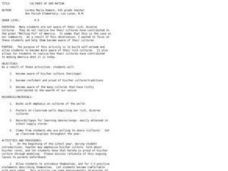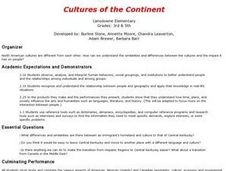Curated OER
Cultures for Elementary Students
Students research one or more cultures. They determine what aspects of the culture to research based on their interests. They develop a research proposal and share it with the class.
Curated OER
Cultural Practices and Products of the Local Community
Third graders examine and compare practices and products of the cultural groups that have settled in the local area. Students develop and use graphic organizers to aid them in the comparison of artistic expression, places of worship,...
Curated OER
What is Culture?
Students discuss "culture." In groups, they discuss and share things about their culture, recording everything they discuss on butcher paper to be hung around the room. They choose a way to share something about their own family...
Curated OER
Comparing Cultures
Students examine the nature of culture, and compare/contrast various cultures and their artifacts and ceremonies. They develop a class list of artifacts, complete a worksheet, and create a poster or diorama describing an object that is...
Curated OER
Cultures of Our Nation
Students bring in family items that represent their culture and present them to the class. In this culture lesson plan, students can bring in food, music, dance, pictures, and more.
Curated OER
Cultures
Students examine and analyze photographs of other cultures. They answer discussion questions, identify bias and point of view in the images, conduct research on another photo, and compare and contrast two cultural images.
Curated OER
Understanding Europe: A Cultural Mosaic (Theme 1)
Students discuss the cultural similarities and differences found in Northen Europe, Southern Europe, Western Europe, and Eastern Europe and create daily journal entries charting their discoveries. This lesson is the First Part in a Four...
Curated OER
Our Cultural Classroom
Second graders are introduced to the cultural diversity within their own classroom and relate this diversity to community, country and world. They create a visual family culture poster containing different aspects of their personal culture.
Curated OER
Cultural Diversity
In this cultural diversity worksheet, students respond to 7 short answer questions and answer 14 fill in the blank questions regarding the components of culture.
Curated OER
Cultures Around the World
Students explore the concept of culture. In this culture activity, students discuss how clothing, food, celebrations, holidays, and travel contribute to the formation and perpetuation of culture.
Curated OER
Modern Culture and Society
Sixth graders investigate different cultures by comparing the United States to Europe. In this social structure lesson, 6th graders discuss the economies, religions, languages and cultures in the Americas and Europe and define their...
Curated OER
Cultures
Students research different cultures around the world. They discover that each culture is a way to express oneself. They compare and constrast how different cultural events are celebrated and draw their own conclusions about them.
Curated OER
Cultural Diversity
Young scholars examine their relationships to cultural groups and make conclusions about their diverse roles in different cultures. They decide why people play multiple roles in society while creating a cultural treasure chest.
Curated OER
Accordion Book for Comparing Cultures
Fourth graders are introduced to the different cultural groups that have settled in Ohio. In groups, they research and describe the products and cultural practices of each group. Using the information, they create an accordion book for...
Curated OER
The Far Reaches of Greek Culture
Ninth graders study the culture of Greece. In this World History lesson, 9th graders research specific data in relation to Greece. Students create a presentation of their findings for their class.
Curated OER
Culture Universals Lesson Plan
Students perform research on specific cultures. They write a short paragraph on each of the universals and explain how each universal relates to their home culture.
Curated OER
Social Studies: Cultural Collage
Students define and discuss cultural aspects and family origins. By citing examples of traditions and customs from other countries, they develop an understanding of cultural influences on society. Finally, students create collages...
Curated OER
Cultural Characteristics
Young scholars are introduced to the various types of cultures found in the world. Using the internet, they research a culture they are interested in and answer comprehension questions. In groups, they demonstrate in a PowerPoint...
Curated OER
Inuit Culture: The Family
Students examine the attributes of Inuit families. In this cultural practices lesson plan, students read "Saqiyuq: Stories for the Lives of Three Inuit Women," and respond to 10 comprehension and critical thinking questions about the...
Curated OER
History and culture through food
Students select a favorite family recipe and research the recipe and its ingredients using a variety of sources on the Internet. Each student then creates a recipe flyer for a class cookbook that includes their recipe and the historical...
Curated OER
Cultures of the Continent
Students explore the various cultures of North America. They examine the differences and similarities between an immigrant's homeland and the culture of Central Kentucky. Students discuss strategies to make the transition easier for...
Curated OER
Cultural Mapping
Students are introduced to the cultural diversity in Australia. Using new vocabulary, they define multiculturalism and explore their own cultural backgrounds. In groups, they complete a series of worksheets to develop a better sense of...
Curated OER
What is Culture?
Students explore the concept of culture. They discuss the Washoe culture, create a word web, develop a family tree of their own family for a class book, and complete a writing assignment.
Curated OER
Cultural Exchange
Learners are introduced to the concept of cultural exchange and identify two examples of the concept. Individually, they research two specific examples of exchange and write about how it affected the two groups involved. They identify...























